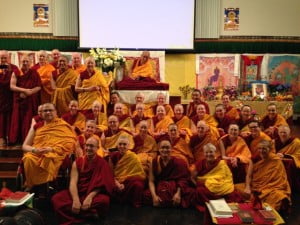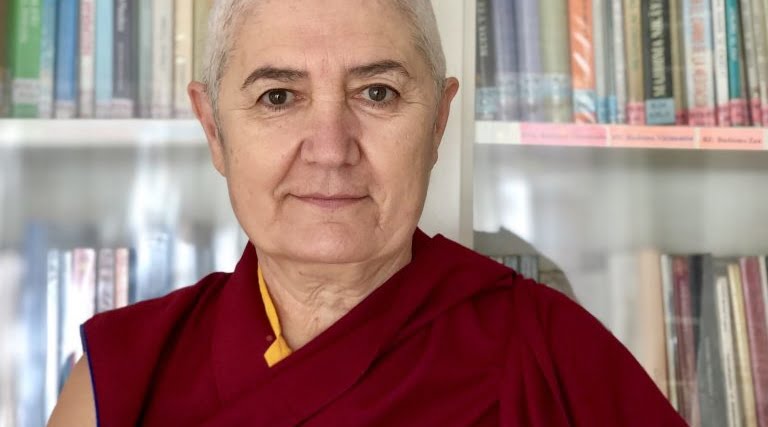Strong determination, which comes out of the understanding of the consequences of our actions of body, speech and mind, will bring caution and mindfulness to our lives. Loving kindness is absolutely fundamental.
Sexual Energy and Intimacy in the Context of Celibate Life Or What to do When Passion Drives us Crazy
By Ven Thubten Saldon
A rather common problem among monastics is finding the appropriate tools to manage two qualities of our energy that don’t stop just because we take the vow not to act on them. One is our sexual energy and the other is the more refined and subtle emotional need for intimacy. They usually arise together and it is difficult to disentangle them to be able to work with them in a more effective way.
As Keith Clark, a Capuchin monk writes in Being Sexual. and Celibate:
“Celibate people are sexual. Human sexuality is about intimacy. The least likely candidate for a celibate life is one for whom sexuality is hidden and forbidden. The most likely candidate is the one who acknowledges and owns her/his sexuality in all aspects – biological, bio-psychological and personal/spiritual- and can talk about it.”
For many of us, during the first years after our ordination (and for many others all their lives) there is a big precaution on our contact with others out of the fear that the ‘passion’ kleshas that are so difficult to manage would arise. That fear can create certain dysfunctional behavior that will affect our relationships and our mental sanity, therefore making it difficult for us to be sane Sangha members with sane bodhicitta practices.
According to Keith Clark, those two energies are intrinsically part of a human being and to repress or ignore them places us at the risk of experiencing a tragedy of celibate life, which “can be to sink below the normal levels of adult behaviour into seeking compensations for certain emptiness within. Abstention from intimacy may foster pettiness, little self-gratifications, hypochondria, fussiness, self-pity or rigidity. This is a caricature, but it may help to indicate where the risk lies for celibate monastics.”
According to the Vajrayana vehicle too, the answer is to transform the energies, never repress them. To do so would be to throw out of the window the chance of realizing the enlightened quality of that specific klesha. Only by looking at the very depth of it may we find its enlightened true nature, and therefore find the true nature of our mind.
To work with this approach we must be very careful to not use it as an excuse to indulge in our afflicted emotions.
I was taught several ways to work with it, using various teachings that were designed to fulfill the needs of different types of practitioners with differing capacities. Which method or methods to apply depends on the specifics of each situation.
No technique will work if we lack several factors: honesty about where we are, strong determination to overcome our defilements based on the understanding of the law of cause and effect, and tons of loving kindness for oneself and compassion for the being towards whom we are having those feelings.
Honesty is needed to accept who we are; to accept that we are not yet perfect and that we most probably will have to work again and again with the same issue. Strong determination, which comes out of the understanding of the consequences of our actions of body, speech and mind, will bring caution and mindfulness to our lives. Loving kindness is absolutely fundamental. If we torture and beat ourselves with guilt and shame, we will just use these techniques to repress and misunderstand the nature of our emotions.
One of the lists about how to work with kleshas includes five different approaches:
1. Abandoning
2. Remedy (Control)
3. Transform
4. Recognize their True Nature
5. Take them as the Path
1. Abandoning – This approach works with the object. It does not work directly with the klesha nor does it look at its nature. Instead, you change the object, avoid it, or create distance from the situation (shifting time or place), and thereby potentially see the consequences of the klesha action. This is just pacification.
2. Remedy – Use antidotes. Two opposing mental factors cannot coexist. So, if you have lust and develop true compassion, the lust disappears because the two can’t occupy the same space. To be successful, this remedy needs to be used repeatedly.
3. Transform – We transform the klesha into emptiness. Transformation through the generation stage is the best if you know how to do this; if not, one can use the sutra point of view to transform through analysis of the twelve links of dependent arising, the five aggregates and 18 dhatus, for example. This is a subtle realization of impermanence, to see that every moment arises and passes away. This realization is quite close to emptiness.
4. Self liberating – Here we don’t work on the klesha; we work with the energy. At this level, the klesha is recognized as wisdom energy. We transform the five kleshas into the five wisdoms. We see the nature of the emotion itself, not the manifestation of it.
5.Take the klesha as the path – Like the peacock, which eats poison in order to brighten the colors of its feathers, here the path is to transform the poison into a means to liberation. One welcomes the poisons, the more the merrier.
We may classify those approaches as Hinayana (the first one), Mahayana (the second) and the rest as Vajrayana.

According to my experience, the first approach is fairly useful as an “emergency first aid,” but unfortunately “abandoning” does not resolve the problem on more than a temporary basis.
The second approach (remedy) requires a lot of previous familiarization with the antidotes and lots of awareness to catch the shenpa at the very beginning. Otherwise, once it has totally arisen, it is too late. We are already overwhelmed and controlled by it.
The third technique (transforming) requires a thorough understanding of emptiness meditation, but I have found that at least a basic intellectual understanding of it can help one to analyze the situation within that framework and to start to deactivate the fixated way in which the situation and the person arise in our mind.
The fourth one (self liberating) is related with the Five Buddha Families. They are five modes of transcendent, primordial knowledge as understood in a tantric framework.
Finally, to take the kleshas as a path, we need lots of honesty and courage and the only thing that can help if we go astray is bodhicitta, so we’d better develop plenty of it!
According to Ven. Pema Chodron, one way of working with kleshas, which combines a few of the above approaches, is to develop a strong shamatha practice. This is the only way to catch the shenpa as soon as it arises, sit still with its energy (take it to your cushion) without attaching a storyline to it, and finally use that raw quality of energy to develop loving kindness and compassion.
How does this work? On the practice level, let’s say that you are feeling longing, desire or liking for a specific person. As you practice to disentangle the raw energy of the klesha from the storyline, suddenly you find yourself with a big amount of “formless” energy that, like clay, you can give the form you choose. One example: you feel enthusiastically open and generous, and instead of focusing on the person you like, you stretch it further and try to encompass all the people around you. What about paying some attention to, or giving some gift to, or acknowledging that person you could never get along with? Or that other person who really needs some attention and care? Or what about offering to do the laundry for the nun that was working so hard all week and feels exhausted? With this approach, instead of becoming narrow due to attachment to one person, you get to expand, open and reach out to many.
A definition of celibacy taken from Christian sources is,
“Celibacy is a deliberate choice to limit one’s freedom at one level in order to develop it at others. Restrain to love one in order to love many.”
As with any other bodhicitta practice, it can feel a bit artificial at the beginning but the more we practice it, the more we feel comfortable and genuine with it.
Finally, yet another hint given by Ven. Pema Chodron is to apply compassion as a way to shift the quality of the feelings you are having towards that person (lust or emotional longing) and towards yourself (guilt, remorse, unhappiness).
This process starts by connecting with an opening that Chogyam Trungpa Rinpoche called the “soft spot,” which could be a feeling of love or attraction or any kind of emotional warmth. What we usually want to do next is to perpetuate that warm feeling and as this is unlikely to happen for very long, we start to fear that we won’t be able to keep it, that we will lose it. We get insecure and give rise to attachment, which is a hardening of that “soft spot.” To avoid that hardening, we can use meditation on compassion.
How does it work? To apply meditation on compassion to ourselves we have to first catch it when that hardening, that limiting quality, is starting, then try to melt it and use it as a stepping stone. You see what you are doing (hardening, getting narrow) and you develop the strong wish not to be caught like that. You can let yourself feel the torture, the pain of being hooked, and you can do tonglen for yourself to start with, then you can expand it and do it for all the people who in that very moment are feeling the same pain. In this way you are using the poison (the pain of attachment) as a path to develop compassion.
To develop compassion for the other person, put yourself in that person’s shoes. Look at her or him and have the real wish for her or him to be happy and free from suffering. Ask yourself with total honesty: “What does this person need in order to have the root of happiness? In what way can I contribute to that? In which ways am I an obstacle for that to happen?”
Compassion melts that fixation on how we want the other person to relate with us, how we want the relationship to be. Compassion definitely shifts the central point of attention from me (from self-cherishing, self-absorption, a self-gratifying attitude) to her or him (to loving kindness and compassion) and invites one to consider: “How can I benefit that person in the long term?”
I would like to end with some advice from H.H. The Dalai Lama on dealing with strong kleshas on the spot. He said: “Visualize your guru on top of your head, offer him or her a mandala, and strongly pray.”



